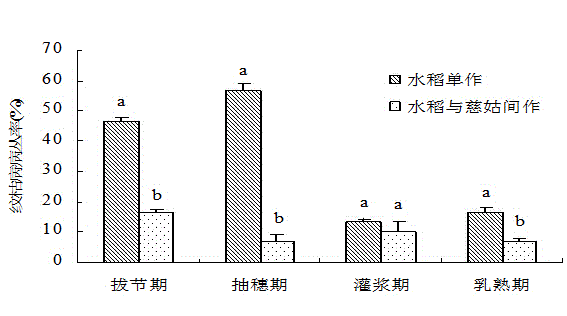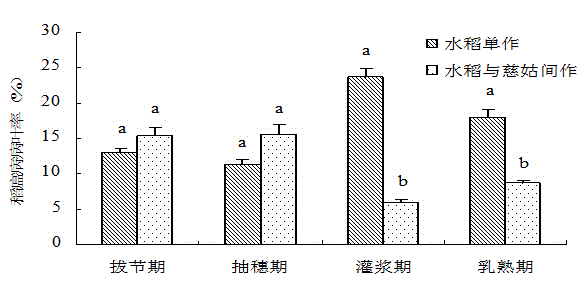Method for controlling rice blast and sheath blight by intercropping sagittaria sagittifolia in rice field
A technology for rice blast and sheath blight, applied in the fields of botanical equipment and methods, rice cultivation, horticulture, etc., can solve the problems of increasing the resistance of bacteria, environmental pollution, pesticide residues, etc., and achieve obvious ecological benefits, easy operation, good control effect
- Summary
- Abstract
- Description
- Claims
- Application Information
AI Technical Summary
Problems solved by technology
Method used
Image
Examples
Embodiment 1
[0023] The rice variety selected in this example is Huanghuazhan (Yueshendao 2005010), and the arrowroot variety is a local species in Daao Town, Xinhui, Jiangmen City. This study is divided into three experimental treatments, one of the experimental paddy field A is rice monoculture treatment, no pesticides are used; the sagittarius plantation field B is treated with sagittarius monoculture, no pesticides are used; the experimental paddy field C is treated with rice and sagittarius intercropping way, without using pesticides. Each of the three experimental treatments was repeated three times and arranged in random blocks. The planting methods and other daily management of rice or sagittarius in treatments A and B were the same as the management methods of rice and sagittarius in treatment C of the intercropping experiment.
[0024] The specific production management operation process of experimental treatments A, B, and C is as follows:
[0025] S1. The stage of rice and ar...
Embodiment 2
[0035] The rice variety selected in this example is Hemeizhan (Yueshendao 2008006), and the Sagu variety is Shagu from Guangzhou, Guangdong.
[0036] S1. The stage of rice and arrowroot planting.
[0037] S11. Soil preparation and preparation for planting rice and sagittarius: rice seedling raising, leveling the paddy field. Apply basal fertilizer about 20 days before rice transplanting, and the standard of basal fertilizer application is every 667m 2 Apply 1400kg of decomposed chicken manure, then transplant rice seedlings, and transplant 90cm plant height and 30cm crown width of Sagittarius seedlings after another 7 days; rice seedlings and Sagittarius are intercropped at 4:2, that is, 2 rows of Sagittarius are planted for every 4 rows of rice intercropping The distance between the paddy rice planting zone and the sagittarius planting zone is 27cm; the row spacing of the rice seedlings is 17cm×18cm, and the row spacing of the sagittarius seedlings is 30cm×35cm.
[0038] S1...
Embodiment 3
[0046] The rice variety selected in this example is Yuejingsimiao No. 2 (Yueshendao 2006067), and the Sagittarius variety is Bairou Sagittarius from Guangdong.
[0047] S1. The stage of rice and arrowroot planting.
[0048] S11. Soil preparation and preparation for planting rice and sagittarius: rice seedling raising, leveling the paddy field. Apply basal fertilizer about 20 days before rice transplanting, and the standard of basal fertilizer application is every 667m 2 Apply 1000kg of decomposed chicken manure, then transplant rice seedlings, and transplant 80cm plant height and 30cm crown width of Sagittarius seedlings after another 7 days; rice seedlings and Sagittarius are intercropped at 5:3, that is, 3 rows of Sagittarius are planted for every 5 rows of rice intercropping The distance between the paddy rice planting belt and the arrowhead planting belt is 33cm; the row spacing of the rice seedlings is 17cm×22cm, and the row spacing of the arrowroot seedlings is 35cm×40c...
PUM
 Login to View More
Login to View More Abstract
Description
Claims
Application Information
 Login to View More
Login to View More - R&D
- Intellectual Property
- Life Sciences
- Materials
- Tech Scout
- Unparalleled Data Quality
- Higher Quality Content
- 60% Fewer Hallucinations
Browse by: Latest US Patents, China's latest patents, Technical Efficacy Thesaurus, Application Domain, Technology Topic, Popular Technical Reports.
© 2025 PatSnap. All rights reserved.Legal|Privacy policy|Modern Slavery Act Transparency Statement|Sitemap|About US| Contact US: help@patsnap.com


